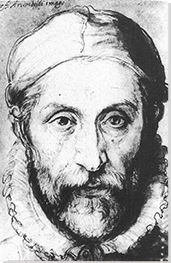Summary of Giuseppe Arcimboldo
Arcimboldo was an Italian Mannerist painter known for his extraordinary, and sometimes monstrous, human portraits. His unique collage style, which embodies a true surreal wit, is comprised of fruit and vegetables, animals, books, and other objects. Though he was viewed as an eccentric (or, at worst, insane), and though his most famous works were sometimes dismissed as little more than curiosities, Arcimboldo's paintings were in fact complex compositions, rich in both paradox and allegory. It is thought that the subtleties in his paintings might have been lost on the general public but the Habsburg emperors (for whom he worked for more than 25 years) were so pleased with Arcimboldo's work that Rudolph II made him a Count Palatine in 1592, after he had returned to Milan. His paintings have been cited as precursors to Surrealism and were highly prized by Salvador Dalí and other members of the movement.
Accomplishments
- As the most radical and extravagant exponent of the Mannerist style, Arcimboldo's artwork is remarkable for the way he pushed the theme of the parallel between mankind and the natural world to new limits. His portraits, made of composite flora and/or fauna arrangements, have been at the same time likened to symbolic picture puzzles.
- Arcimboldo honed his talent for playing tricks on the eye through his fantastical - such as a three-headed dragon costume to be fitted to a horse - and allegoric - drawing on such themes as "grammar," "geometry," "astrology," "music" and "rhetoric" - pageant outfit designs.
- The idea of the reversible image - known subsequently as the "Arcimboldo palindrome" - saw the same image take on a different meaning once it is reversed (a regular palindrome is a word that reads the same frontally and in reverse). Seen from one angle we have a still life; when rotated 180 degrees we discover a typical Arcimboldo composite head. The fashion for picture puzzles notwithstanding, the "Arcimboldo palindrome" represented something more like a pictorial metamorphosis and can be read thus as the artistic equivalent of "elite magic" as advocated by his court colleagues, the alchemists.
- Historians have speculated over possible precursors (such as the ceramicist Francesco Urbini) to Arcimboldo's unique style of so-called teste composte ("composite head") painting. What one sees so unambiguously in Arcimboldo's unique compositional cornucopias, however, is his strong leaning towards the more imaginative and fanciful elements of the Mannerist style. Though his portraits were truly idiosyncratic (and therefore not to everyone's tastes) the progressive Habsburgs delighted in inventive artistic interpretations and it was well known that the Imperial Court was welcoming of intellectuals and avant-gardists.
- Though he remained true to his signature teste composte technique, portraits in his later period could be executed with the skill of a miniaturist possessed with the scientific knowledge of a botanist. His mature portraits were less indebted to collage offering more in terms of an exquisite accuracy in the merged detail of their flora.
The Life of Giuseppe Arcimboldo
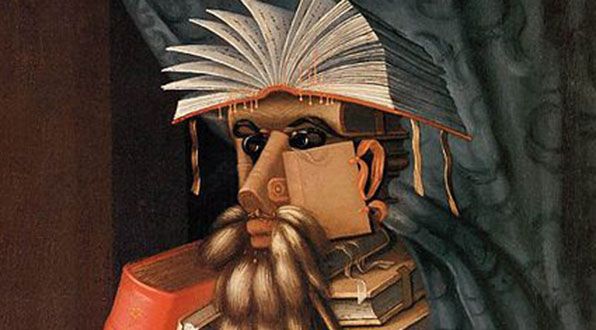
Arcimboldo’s portraits made up of fruit, vegetables and flowers are still incredibly popular many centuries after their creation. Less well-known however are his other portraits, made up of meat, fish and even inanimate objects. In his intriguing and almost Surrealist The Librarian (1566), a work cleverly made up of books, it is thought that the artist was poking fun at members of the wealthy but unintelligent elite, who would collect literature as a status symbol, but were totally unable to read their contents.
Important Art by Giuseppe Arcimboldo

Maximilian II, His Wife, and Three Children
Shortly after his appointment to the Habsburg court, Arcimboldo painted the unexceptional (in that the subject matter and style conformed to all the usual conventions associated with royal portraiture) Maximilian II, His Wife, and Three Children. However, Maximilian II is an important work in his oeuvre because it serves to illustrate an intermediate phase in the artist's move towards the full Mannerist style which came to stunning fruition only a year later through his commencement of his famous Four Seasons portraits. Indeed, the Four Seasons gave an indication of the wit and inventiveness for which Arcimboldo is much better known. The evolution of his unique style still remains difficult to trace, however, owing to the fact that so much of Arcimboldo's "conventional" work has been lost. Nevertheless, it is clear to see that his use of fruits, vegetables, animals and plants refer further back to his youthful nature studies. One might also find "Arcimboldesque" montage qualities in the artist's aforementioned stained glass works (little of which survives).
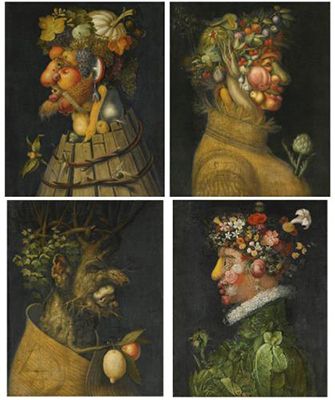
Four Seasons
Four Seasons is a series of four paintings, for which Arcimboldo is still perhaps best known. The series can be seen as the epitome of the Mannerist trait which emphasises the close relationship between mankind and nature. Each portrait represents one of the seasons and is made up of objects that characterise that particular time of year. Spring is a smiling young woman, whose face comprises pink and white blossom skin with a lily-bud nose and the ear of a tulip. Her hair is made up of colorful flowers while her dress is made of green plants and a white floral ruff. Summer is made up of seasonal fruit and vegetables, whose bright colors stand out against the dark background, Summer's smiling face reassures the viewer of the warm benevolence of the sunshine season. Autumn shows a man whose body is a broken barrel and whose face comprises a pear (nose), apple (cheek), pomegranate (chin) and mushroom (ear), all ripe to bursting. Autumn demonstrates the fertility of the seasons and, in his protruding tongue, the artist's anticipation for these ripened fruits. Winter is an old man wrapped in a straw mat. He is made up of an aged tree stump, with pieces of broken-off branch and scratched bark for his features, and a swollen mushroom for a mouth.
Whilst only Winter and Summer survive from the original series of Four Seasons paintings, Arcimboldo's patron, the Emperor Maximilian II, liked them so much that he commissioned a second set in 1573 as a gift for Augustus, the Elector of Saxony (it is the second set that remains intact). As a further expression of his appreciation, the Emperor participated in a festival in 1571, directed by Arcimboldo, in which he and other members of his court dressed up as the elements of seasons.
Additionally, the four portraits in Arcimboldo's later series Four Elements (1566) - Air, Fire, Earth and Water - correspond with spring, summer, autumn and winter respectively. The overall effect of the two series is to suggest thus that the Holy Roman Emperor Maximilian II (who commissioned both sets of paintings) influences everything on the earth down to its most primal forces. By combining objects and creatures into faces, moreover, Arcimboldo transforms chaos into harmony, which could also be seen as a reflection on the Holy powers of the Emperor. As art historian Thomas DaCosta Kaufmann confirms: the paintings were intended to be humorous, but "the humor resolves itself in a serious way," probably as a comment on the majesty of the ruler.
Oil on canvas - Louvre Museum, Paris
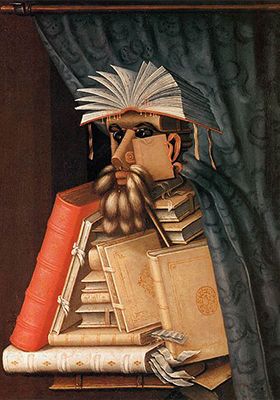
The Librarian
Though Arcimboldo is best known for his portraits made up of flowers, vegetables and fruits, the artist also made several portraits made of other assembled objects with relevance to the sitter. For example The Waiter (1574) depicts a server made up of crockery, whilst this portrait, The Librarian, is made up of objects that were associated with libraries. These include books (comprising the body, head and hair), study room curtains (the clothing) and animal-tail dusters (the beard).
Perhaps owing to the nature of the subject matter, the overall impression of the figure is quite disjointed in comparison to previous portraits. The hard edges of the books disrupt the overall impression of a portrait and render the subject robotic in appearance. It is possible that this lack of humanity is a contributing factor to the controversy surrounding this portrait, arising from the suggestion that Arcimboldo intended this portrait to mock scholars and the wealthy elite.
Since books were available only to the very rich, many owners collected them as status symbols whilst being unable to read the contents of their collections. The subject of this portrait is made up of books yet brings no additional contribution or personal characteristics to the table. Unlike Arcimboldo's portrait The Jurist of the same year, the subject of the portrait has not been identified. This might also suggest that Arcimboldo had in mind a group or class of people as opposed to an individual.
Oil on canvas - Skokloster Castle, Sweden
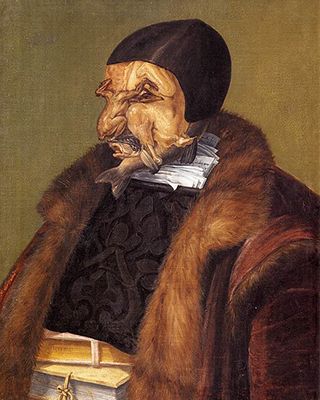
The Jurist
The Jurist is a disturbing portrait of a member of the legal profession. His head is made up of poultry and fish and his body of legal documents. Whereas in previous portraits (such as Four Elements) Arcimboldo has chosen the collaged elements to represent the nobility and benevolence of his patrons, this portrait is intended to discredit and defame. The use of meat and poultry to make up the lawyer's face illustrates the artist's attitude towards his subject. The expression on the lawyer's face is sneering and his very person is made up of what is thought to be rotting flesh. Particularly distasteful are his fish-bone moustache, fish tail beard and decapitated frog nose.
It is not known with any certainty whether the sitter is a particular lawyer or if The Jurist is a caricature of the legal profession in general. According to the Nationalmuseum in Stockholm, however, the painting shows the German jurist Ulrich Zasius, vice-chancellor of Maximilian II. If the portrait does indeed show Zasius, then the poor light in which he has been painted could be a reflection of his reputation for dishonesty in his service to the Emperor - the first intended viewer of this portrait. It is also possible that Arcimboldo's portrait mocks Zasius's disfigurement, which he is thought to have contracted as a result of a sexually transmitted disease.
Oil on canvas - Nationalmuseum, Stockholm, Sweden
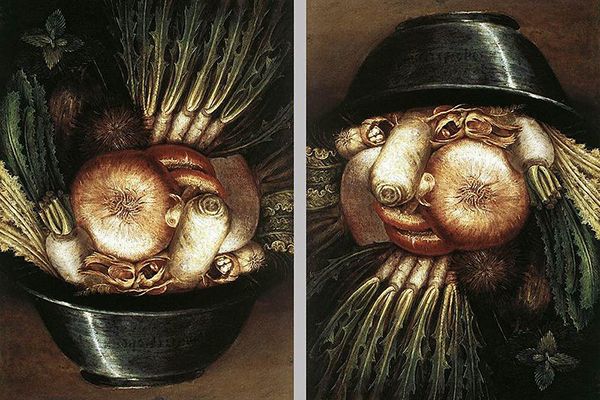
Vegetables In A Bowl Or The Gardener
This painting is one of several by the artist that can be viewed in reverse, showing a still-life from one perspective and a portrait from the other (sometimes referred to as an "Arcimboldo palindrome"). It is thought that Arcimboldo painted the works first as still lifes, subsequently rotating them to reveal and adjust the faces. X-ray evidence shows that this process often required the artist to repaint some of the fruits, having changed their positions.
The similarities of the work to visual puzzle responds to the Renaissance fascination with such riddles and David Alan Brown describes the viewer of these kinds of works as "hav[ing] the same pleasure, as if they were playing a game." Since the 20th century, works such as this one have also become of interest to psychologists and scientists concerned with optical illusions, multiple images and face recognition.
Focusing more on the subject matter than the composition of the portrait, authors Dr. Emil Krén and Dr. Dániel Marx have highlighted the sexual connotations of this portrait, claiming that the cheeks and nose are reminiscent of male sex organs and the lips to female genitals. As such, they propose that the figure portrayed could be the Greek god of fertility and protector of horticulture, Priapus. This would correspond with others of Arcimboldo's works that represent deities, for example Flora (1589) and Vertumnus (c.1590-1591).
Oil on wood - Museo Civico "Ala Ponzone", Cremona, Italy
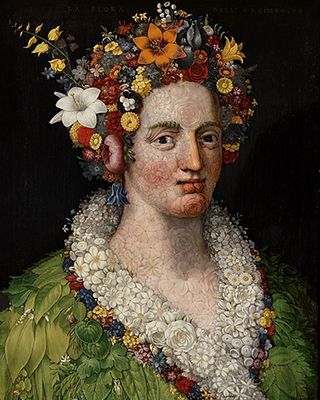
Flora
The subject of the portrait is Flora, the Roman goddess of flowering plants, fruit and the spring. Typically for the artist, her form is composed of whole flowers, buds, petals, stems and leaves. However this portrait, and Vertumnus which follows it, stand out from their predecessors due to their subtlety and delicacy of technique.
Whereas Arcimboldo's portraits could be grotesque, Flora adheres more to traditional understandings of beauty in portraiture. The artist's use of miniature flowers to compose the entire image in such detail has endowed the subject with a convincing sense of three-dimensions and allowed him to carefully delineate the features. This approach contrasts with his previous portraits which are more ostensibly collaged. The result also partly recalls the aesthetic of delicate stained glass, with which the artist had worked as a young man.
The following year, Arcimboldo painted Flora meretrix as a companion to this portrait. The subject matter of the latter is the same, however the treatment is softer, giving the painting a romantic haze that perhaps takes away from some of the precision the artist shows here in depicting the flora. His attention to the various species of flower is akin to that of a horticulturalist and as such, some critics have suggested that the work is a precursor to Baroque still life, characterized by its faithful representation of natural objects. Arcimboldo sent this work to the Emperor Rudolf II in gratitude after he was ennobled as Count Palatine in 1592. It would have appealed to the Emperor's intense interest in botany and horticulture.
Oil on board - Private Collection
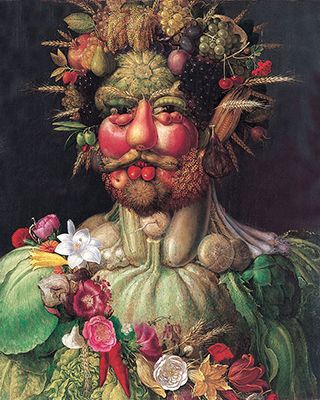
Vertumnus
Vertumnus is a portrait of the Holy Roman Emperor Rudolf II, whom the artist has portrayed as the eponymous Roman god of the seasons, growth, gardens, fruit trees and metamorphosis in nature. It was painted after Arcimboldo returned to Milan and is made out of flowers as well as fruits and vegetables from all four seasons, including apples, pears, grapes, cherries, plums, pomegranates, figs, beans, peas in their pods, corn, onions, artichokes and olives.
The composition of the human subject using natural forms, which is typical of Arcimboldo's portraits, here represents the harmony between the rule of the Emperor and the rule of nature. The abundance of produce is symbolic of the return of a so-called Golden Age - a flourishing of nature, culture and prosperity - under Rudolf II's rule. As such, the portrait flatters the Emperor, perhaps unsurprisingly, given that he was Arcimboldo's employer and patron for eleven years. Rudolf II was, however, not generally a popular ruler. It seems, therefore, that connotations of godliness, power and prosperity would help to improve his public image. Vertumnus was one of the last works that Arcimboldo painted and, with Flora (1588), it is often considered his most accomplished artwork.
Oil on panel - Skokloster Castle, Sweden
Biography of Giuseppe Arcimboldo
Childhood
The lineage of the Arcimboldo family was documented by his friend, the Milanese art critic and travelogue author, Paolo Morigia. From his account, we know that Giuseppe Arcimboldo came from a noble background. His great uncle had held the position of Archbishop of Milan and, as a result of his influence, the young Giuseppe would likely have been introduced to artists, scholars and writers from a young age. His father, Biagio Arcimboldo was himself a lesser known painter (fabbrica) who worked in the Duomo (cathedral) in Milan. Although precise details of his upbringing remain scarce, it is reasonable to suggest that, through his father's influence, Giuseppe would have been introduced to painting as a young boy and that he developed his skill and talent from an early age.
Education and Early Training
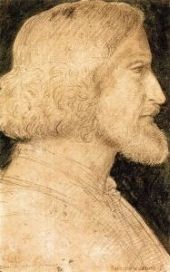
Arcimboldo trained in stained glass design and fresco painting, producing work for local cathedrals from the age of 21. His career took a decisive step forward in 1549 when he was commissioned to design stained glass windows for the Duomo. Other opportunities of note followed. In 1551, Arcimboldo painted coats of arms for the future Emperor, Ferdinand I; in 1556, he painted frescoes for the Cathedral of Monza; and, in 1558, he drew the cartoon for the Dormition of the Virgin tapestry, which remains on display in the Como Cathedral in Lombardi to this day.
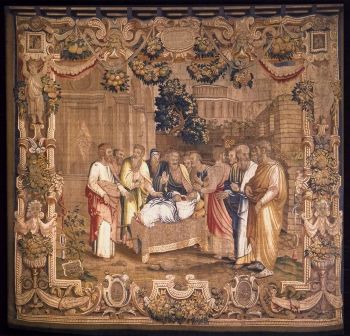
These eye-catching commissions, when added to the artist's remarkable nature studies, confirmed his rising reputation. Morigia, wrote: "This is a painter with a rare talent [...] having proved his worth both as an artist and as a bizarre painter, not only in his own country but also abroad, he has been given the highest praise, in that word of his fame has reached the Emperor's court in Germany." The "Emperor's court" referred to the Habsburg court in Vienna (and subsequently Prague), to which Arcimboldo was summoned in 1562 as court portraitist to Ferdinand I. Given that Milan's newly appointed archbishop was insisting on a more traditional visual language from the city's religious artists, the move to Vienna came at an opportune moment for a nonconformist like Arcimboldo. The artist had found a home and would eventually spend over 25 years in service to the Habsburgs: to Ferdinand I, his son, Maximillian II (reigned 1564-1576) and Ferdinand's grandson, Rudolf II (reigned 1576-1612).
Mature Period
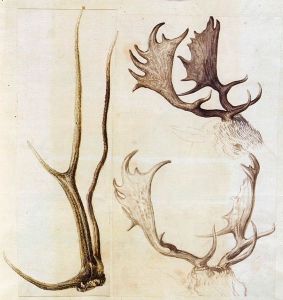
Though his most famous works challenged many of the orthodoxies of the day, Arcimboldo arrived at the Habsburg court with all the kudos of a qualified Renaissance master. However, the Habsburg court cultivated a mood of progressive thinking and Arcimboldo - who worked next to astronomers, botanists, zoologists, physicians and alchemists (otherwise known as the practitioners of "elite magic") - revelled in the creative freedoms offered by a court that saw itself as the leading center for arts and sciences in Europe. He duly blossomed as a portrait painter, and also as a decorator, a costume designer and the organizer/planner for lavishly themed balls (at which he may also have painted guests' portraits). As Morigia wrote "This noble and inspired man fashioned a great number of rare and delicate works of art which caused considerable amazement among all the illustrious noblemen who used to congregate there, and his lord and master was very pleased with him." Arcimboldo was thus paid "a good salary worthy of his merits" leading to a "fulfilling" and "honorable" life.

Moreover, the culture of the court created a fertile environment in which Arcimboldo's talents could develop. He exerted considerable influence over the Emperors, both artistically and personally. He assisted, for instance, Ferdinand I in expanding his curiosity cabinets, which held various exotic species of plants, animals, objects and artworks (along with the collections of his descendants, these cabinets formed the nucleus of the Kunstkammer Vienna museum). While at Habsburg, Arcimboldo also absorbed the influence of artworks by painters including Bosch, Brueghel, Cranach, Grien, and Altdorfer.
Late Period
The last Emperor for whom Arcimboldo worked was Rudolf II. This period, which lasted eleven years, is widely thought to represent the peak of his artistic career. This was due in part to Rudolf's personal interests in horticulture, botany, exotic creatures and objets d'art. In his paintings, Arcimboldo was free to draw on his observations of extraordinary animals and plants that were collected by the Emperor's agents from Europe and held in the Art and Wonder Chambers at court. He continued to produce great works even towards the very end of his life, most notably his Self-portrait as the Four Seasons (1590) and the portrait of Rudolf II as the god of metamorphosis - Vertumnus (1590-91).
Having petitioned the Emperor's permission several times, Arcimboldo finally left the Habsburg service in 1592, departing Prague for his home city of Milan. As a mark of Rudolf II's admiration for him, he was made Count Palatine in the same year and awarded 1500 Rhenish guilders for his "long, faithful and conscientious service." He died in 1593 at the age of 66, with records citing kidney stones (as opposed to the contemporary plague epidemic) as the cause.
The Legacy of Giuseppe Arcimboldo
Many of Arcimboldo's works have been sadly lost as a result of the Swedish invasion of Prague in 1648, during the Thirty Years' War. As such, the contemporary picture of his oeuvre is somewhat incomplete. Furthermore, of the works that are known, many, such as his conventional portraits and religious paintings, have been overlooked. Rather, it is the portraits made up of fruits, vegetables, plants and animals that fascinate artists and critics today. These unique Mannerist paintings have even featured in films (they are referenced in the Harry Potter films, for example), comics, novels and album covers.
In the 20th century, Arcimboldo's work underwent a revival owing to the interests of Surrealists such as Salvador Dalí, for whom Arcimboldo's composite images and allegorical allusions held immense appeal. But it was Museum of Modern Art director Alfred Barr's inclusion of his works in the 1930s exhibition Fantastic Art, Dada, Surrealism that that did most to bring Arcimboldo renewed attention from the art world. Since then, art historians have re-evaluated Arcimboldo's highly individual style, elevating him to the rank of one of the greatest of 16th century Mannerists. The 1987 exhibition "The Arcimboldo Effect: Transformations of the face from the 16th to the 20th Century" at the Palazzo Grassi, Venice, meanwhile, prompted interest in his work from psychologists and scientists concerned with optical illusions, multiple images and face recognition. In 2009 the American artist and filmmaker, Philip Haas, created four large-scale fiberglass sculptures in a three-dimensional homage to Arcimboldo's Four Seasons series. Haas stated: "Playing with Arcimboldo's imagination and reinterpreting it allowed me to make the Renaissance contemporary and make contemporary art have a root in the history of art."
Influences and Connections

-
![Hieronymus Bosch]() Hieronymus Bosch
Hieronymus Bosch -
![Pieter Bruegel the Elder]() Pieter Bruegel the Elder
Pieter Bruegel the Elder ![Hans Baldung-Grien]() Hans Baldung-Grien
Hans Baldung-Grien- Cranach
- Altdorfer
- Rudolf II
-
![Salvador Dalí]() Salvador Dalí
Salvador Dalí -
![Pablo Picasso]() Pablo Picasso
Pablo Picasso - Octavio Ocampo
- Sandro del Prete
- Philip Haas
